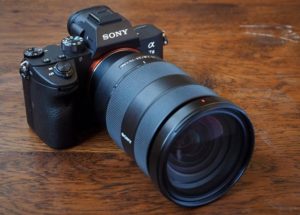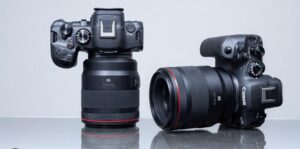Choosing the right camera can be challenging, especially with so many great options on the market. Two popular choices for photographers and videographers are the Nikon D850 and the Sony A7IV. Let’s compare these two cameras to help you decide which one suits your needs best.
Camera Specifications: Nikon D850 vs. Sony A7IV
Nikon D850 Specifications:
- Sensor: 45.7-megapixel full-frame.
- ISO Range: 64-25,600 (expandable to 32-102,400).
- Autofocus System: 153 AF points with 99 cross-type sensors.
- Video Capabilities: 4K UHD at 30fps, Full HD at 120fps.
- Battery Life: Approx. 1,840 shots per charge.
- Weight and Dimensions: 1005g, 146 x 124 x 78.5 mm.
Sony A7IV Specifications:
- Sensor: 33-megapixel full-frame.
- ISO Range: 100-51,200 (expandable to 50-204,800).
- Autofocus System: 759 phase-detection points.
- Video Capabilities: 4K at 60fps, Full HD at 120fps.
- Battery Life: Approx. 610 shots per charge.
- Weight and Dimensions: 658g, 131.3 x 96.4 x 79.8 mm.
Image Quality
Sensor Performance: The Nikon D850 has a 45.7-megapixel sensor. This high resolution is great for detailed images. The Sony A7IV has a 33-megapixel sensor, which also delivers excellent image quality but with slightly less resolution.
Color Science and Image Processing: Nikon cameras are known for their true-to-life color rendering. The D850 produces images with rich and accurate colors. Sony’s A7IV, on the other hand, offers more customizable image processing. You can tweak the colors to match your style.
Autofocus and Shooting Speed
Autofocus Systems: The Nikon D850 has 153 autofocus points, with 99 cross-type sensors. This makes it very reliable for fast-moving subjects. The Sony A7IV has 759 phase-detection points. This gives it a broader coverage and faster focusing speed, especially for video.
Shooting Speed and Buffer: The Nikon D850 can shoot at 7 frames per second (fps) and up to 9 fps with a battery grip. The Sony A7IV can shoot at 10 fps. Both cameras have good buffer sizes, but the A7IV slightly edges out the D850 in terms of continuous shooting.
Video Capabilities
Nikon D850 Video Features: The Nikon D850 records 4K UHD at 30fps and Full HD at 120fps. It also offers 8K time-lapse recording. The video quality is excellent, with sharp and detailed footage.
Sony A7IV Video Features: The Sony A7IV records 4K at 60fps and Full HD at 120fps. It also supports 10-bit 4:2:2 internal recording, making it a strong choice for videographers. The A7IV has additional video features like S-Log profiles, which are great for color grading.
Build and Handling
Design and Ergonomics: The Nikon D850 has a robust and professional design. It’s larger and heavier, which some may find more stable to handle. The Sony A7IV is more compact and lightweight, making it easier to carry around.
Weather Sealing and Durability: Both cameras are well-built and weather-sealed. This makes them suitable for shooting in different environments. The Nikon D850 has a magnesium alloy body, while the Sony A7IV is made from a durable composite material.
Lenses and Accessories
Lens Compatibility and Options: The Nikon D850 uses F-mount lenses. There is a wide range of lenses available, including many high-quality options. The Sony A7IV uses E-mount lenses. Sony has also built a strong lineup of lenses, including many third-party options.
Accessory Support: Both cameras support a variety of accessories. You can find battery grips, external flashes, and other gear for both models. However, Sony’s mirrorless system has a slight edge in terms of newer, more compact accessories.
Price and Value
Cost Comparison: As of 2024, the Nikon D850 is generally less expensive than the Sony A7IV. The D850 offers great value for its high-resolution sensor and robust build. The A7IV is more costly but justifies the price with advanced video features and faster autofocus.
Overall Value Proposition: The Nikon D850 offers excellent value for photographers who need high resolution and durability. The Sony A7IV provides great value for those who need a versatile camera for both photo and video work.
Use Case Scenarios
Who Should Buy the Nikon D850?
- Landscape Photographers: The high resolution and dynamic range are perfect for detailed landscape shots.
- Studio Photographers: The D850 excels in controlled environments with great lighting.
- Wildlife Photographers: The robust build and weather sealing are ideal for outdoor shoots.
Who Should Buy the Sony A7IV?
- Videographers: The advanced video features and 4K 60fps recording are excellent for video production.
- Travel Photographers: The lightweight and compact design make it easy to carry.
- Event Photographers: The fast autofocus and high ISO performance are great for capturing moments in various lighting conditions.
Personal Recommendations
Recommendation Based on User Needs:
- Choose the Nikon D850 if you need a high-resolution, durable camera for photography.
- Choose the Sony A7IV if you want a versatile, lightweight camera for both photography and videography.
Conclusion
Summary of the Comparison: Both the Nikon D850 and Sony A7IV are fantastic cameras. The D850 excels in resolution and durability, while the A7IV shines in versatility and video features. Your choice depends on your specific needs and budget.




